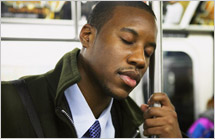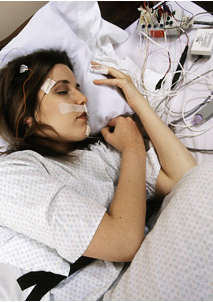Although many problems with sleep can be dealt with through simple changes in routines or in the sleep environment, sometimes a change in behavior is not enough. If you are having a particular problem with sleep that goes on for a period of time, you might want to consult with a sleep specialist.
Sleep specialists are trained to evaluate individuals for sleep disorders. If you are diagnosed with a sleep disorder, it is important to get treatment. Sleep disorders are usually chronic and may lead to other health complications.
Dr. Lawrence Epstein discusses what to expect from a sleep evaluation and sleep study.
An Overview of Sleep Disorders
Too sleepy or Can't sleep? Good news: Sleep disorders are treatableThe Takeaway
- Ignoring sleep disorders can lead to poor health, poor mood, and lethargy, and may negatively impact motivation, relationships, and job performance.
- Self-medicating sleep disorders using over-the-counter (OTC) remedies or alcohol can cause significant side effects, and may make sleep problems worse.
- Sleep specialists can help identify the root cause of many sleep problems and recommend treatments that can improve sleep, health, and quality of life.
Identifying Sleep Disorders
If you spend a great deal of time lying awake in bed at night or frequently nod off during the day, you may have a sleep disorder. A variety of sleep disorders can cause similar symptoms, such as excessive daytime sleepiness. If you suspect you have a sleep disorder, it is important to seek the expert opinion of your physician and/or a sleep specialist.
Dr. Larry Epstein describes the types of questions that doctors should be asking patients about their sleep.
A sleep doctor can help determine not only the origin and severity of a sleep problem, but can also recommend therapies that may help you obtain better sleep. This essay and other features on this site are intended to help you distinguish between normal sleep disturbances and the three broad categories of clinical sleep disorders that require treatment.
Insomnia
On an average night, 30 to 40 million Americans have difficulty falling asleep, staying asleep, or wake earlier than they would like and cannot get back to sleep. These are the major symptoms of insomnia, the most common category of sleep disorders. Although many people with insomnia may accept their symptoms as a part of life, poor quality sleep takes a toll. Studies show that people with insomnia are more likely to become clinically depressed, suffer from poor concentration, and have accidents.
Many people have experienced periods of short-term, or acute, insomnia due to stress or environmental changes, such as job loss or jet lag. Fortunately, for most people these disruptions in sleep may last only a few nights. But in some cases, sleep disruptions persist for long periods and evolve into what specialists call chronic insomnia.
Causes of Chronic Insomnia
Chronic insomnia likely results from a number of biological, environmental and neurophysiologic factors. It is associated with a variety of social stressors (e.g., grief, personal endangerment) as well as mental (e.g., depression) and physical health conditions (e.g., heart disease, asthma). One common conceptual model proposes that persons who develop chronic insomnia have an underlying inherited or acquired predisposition. Insomnia then is initiated by a precipitating event such as loss of a loved one. It becomes chronic by perpetuating factors such as poor sleep habits (e.g., spending excessive amounts of time trying to sleep). Visit Theories That Explain Insomnia to learn more about possible mechanisms that underlie the development of insomnia.
Treatment
In many instances, resolving underlying health issues or changing external factors may be the best approach to relieving the symptoms of insomnia. If underlying health issues cannot be quickly resolved, or environmental factors cannot be identified or changed, then a variety of other treatment options can help. Visit Treatments for Insomnia to learn more about different treatments for chronic insomnia.
Behavioral techniques
- Improved sleep habits, also called sleep hygiene, include such steps as regularizing one's sleep and wake-up times (including on weekends), ensuring the environment is conducive to sleep, and avoiding daytime naps and other behaviors, as well as substances that can interfere with sleep (e.g., caffeine, exercise) should become an integral part of any insomnia treatment program, but alone is unlikely to be effective.
- Cognitive behavioral therapy addresses the worries and fears of not falling asleep that sometimes can keep you awake. It is the most effective treatment.
- Meditation and biofeedback ease stress and promote relaxation also can be helpful.
Prescription medications
- Hypnotics or sleeping pills can be effective for treating chronic insomnia, but cognitive behavioral therapy should be tried first.
- Some antidepressants can also promote sleep by virtue of their sedating effect, but have not been formally tested for this purpose and are not approved for this indication by the US Food and Drug Administration.
Over-the-counter sleep medications and remedies
Some of these may be successful in individual cases. Sleep aids often contain an antihistamine, which causes sleepiness but also can cause daytime drowsiness. Of the many herbal sleep remedies promoted as sleep aids, none has been conclusively found to be effective.
Dr. Larry Epstein discusses the use of over-the-counter medications for sleep.
Excessive Daytime Sleepiness (EDS)

© Steve Prezant/Corbis
It is not unusual for people to have days when they struggle to stay awake. However, suddenly falling asleep on the job or while driving is not normal—and can be extremely dangerous. Excessive daytime sleepiness (EDS) is a symptom that can be seen in several sleep disorders, including obstructive sleep apnea, narcolepsy, and periodic limb movement disorder.
Obstructive Sleep Apnea (OSA) is an extreme form of snoring in which an individual’s airway becomes partially or completely blocked many times during a night of sleep, leading to repetitive awakenings. As we sleep, muscles in the throat relax. In some people, this relaxation causes tissue at the back to the throat to block the airway. In someone with a severe form of OSA, this may occur hundreds of times per night, interrupting breathing for 30 seconds or more during each instance.
The result of this interrupted breathing pattern is severely disrupted sleep, as the individual must wake up enough to regain muscle control in the throat and to reopen the airway. Surprisingly, despite dozens or even hundreds of awakenings per night, most individuals with OSA have no recollection of these events. In fact, often the only evidence of this serious condition is daytime fatigue and reports of loud snoring from bed partners.
One of the biggest risk factors for OSA is obesity. This may be because excessive weight increases the amount of tissue in the throat and thus makes airway obstruction more likely. Other risk factors include inherited traits, such as small jaw size or large overbite, as well as behavioral factors such as the use of alcohol before sleep.

OSA is a serious condition that can lead to high blood pressure, heart disease, and mood and memory problems. As such, those who suspect they may have OSA should consult their primary care physician, who may in turn refer them to a sleep specialist for an overnight sleep evaluation.
Treatment
- Weight loss is one of the most strongly recommended preventative therapies for weight-related OSA. Although results vary, weight loss may ease the severity of the disorder or eliminate the problem altogether.
- Continuous positive airway pressure (CPAP) is the first line of treatment for moderate to severe cases of OSA. During sleep, the CPAP device keeps the airway open by sending a constant, low-pressure stream of air through the nose and into the airway.
- Position therapy is somewhat less effective; however, some individuals have OSA only when they sleep on their back. This means they can successfully reduce OSA symptoms by sleeping on their side instead.
- Dental devices, which are designed to reposition the lower jaw in a way that keeps the airway open, work well in some individuals with mild to moderate OSA.
- Other treatment options include surgical procedures that widen the airway so that it is less likely to close during sleep.
- As yet, no medications have been shown to be effective in treating OSA.
Visit APNEA to learn more about OSA.
Narcolepsy is best known as an almost uncontrollable need to fall asleep at various times throughout the daytime. Although excessive daytime sleepiness is common among people with narcolepsy, the sudden onset of sleep, or "sleep attacks," are less so. Affecting approximately one in two thousand people, narcolepsy is a central nervous system disorder in which the brain cannot properly regulate cycles of sleep and wakefulness. This results in an inability to stay awake for prolonged periods of time, and sleep itself can also be quite disturbed.

Other symptoms include:
- Cataplexy—sudden muscle weakness or reversible paralysis in the legs, arms, or face. In extreme cases, an individual may fall down, appear to be asleep, and remain unable to move for seconds to minutes, yet remain fully conscious.
- Hypnagogic hallucinations—intense dream-like experiences that occur during transitions to sleep.
- Sleep paralysis—the inability to talk or move for a short time when waking up or falling asleep.
Treatment
The diagnosis of narcolepsy sometimes requires daytime sleep testing as well as an overnight sleep study. While there is no cure, narcolepsy can be treated with stimulants to reduce daytime sleepiness and antidepressants and other medications to prevent cataplexy, sleep paralysis, and hypnagogic hallucinations. Scheduling daytime naps at convenient times may help to overcome the problems caused by unscheduled "sleep attacks." Visit NARCOLEPSY to learn more.
Periodic Limb Movements of Sleep (PLMS) is a condition affecting approximately 34 percent of adults over the age of 60. This condition causes involuntary kicking and jerking movements of the legs and arms, often repeated hundreds of times during the night. Like people with sleep apnea, people with PLMS are usually unaware of their multiple nighttime awakenings unless they are witnessed by a bed partner. In extreme cases, these brief arousals following the leg movements disturb sleep so much that they cause excessive daytime sleepiness. In that situation, this is called periodic limb movement disorder (PLMD) and treatment may help with the symptoms of EDS. Patients with restless legs syndrome (an uncomfortable urge to move the legs) often have periodic limb movements during sleep.
Treatment
PLMD is typically treated using medications that have been shown to be useful in treating the movement disorder Parkinson’s disease. In some cases, sleeping pills may be used to prevent arousals caused by limb movements.
Other conditions that can cause EDS include advanced or delayed sleep phase syndromes, which result from abnormal time alignments between the preferred sleep-wake schedule and the phase of the internal clock. There are also numerous medical conditions, such as neuromuscular disorders, that can cause sleep to be fragmented and cause EDS.
Restless Legs Syndrome
Restless legs syndrome (RLS) also known as Willis-Ekbom Disease, is a condition characterized by unpleasant and sometime painful discomfort in the legs and the irresistible need to move them. The symptoms usually occur in the evening when a person lies down to go to sleep. However, they also can occur during the day whenever a person is resting such as sitting in a chair. The discomfort is relieved by moving the legs or walking. Because the symptoms occur in the evening when a person is attempting to sleep, persons with RLS often have insomnia and suffer from sleep deficiency. This can lead to daytime sleepiness. The occurrence of symptoms is variable with some persons having them nightly and others experiencing more sporadically. The cause of RLS is still under investigation. However, there is some evidence that abnormalities of dopamine, a chemical in the brain, as well as a deficiency in iron are contributing factors. In addition, RLS can run in families and may temporarily occur in pregnancy. Periodic limb movements are a common finding among persons with RLS, but are not a requirement to make the diagnosis. Treatment for RLS includes activities such as baths and massages, iron replacement and various medications such as those used to treat PLMD.
Parasomnias
Sleep can be a harrowing time for people who experience parasomnias. The symptoms of these disorders range from the mundane to the horrifying, and worrying about what might happen during a night of sleep can cause some people who experience parasomnias to want to avoid sleep. The three most common types of parasomnia are:
- Sleepwalking—Once thought to be an acting out of dreams, sleepwalking actually takes place during deep sleep (not REM sleep, when dreams typically occur). Sleepwalkers often perform routine activities such as dressing and cleaning. Sleepwalking is quite common in children and affects approximately 1 percent of adults. Bouts of sleepwalking can be triggered by stress, anxiety, excessive alcohol, or epilepsy.
- Night terrors—These severe attacks cause people, usually children, to appear to wake up and scream in fear or panic. However, these individuals are typically inconsolable, and tend to have no recollection of the event the following day.
- Sleep-eating disorders—These episodes, like sleepwalking, occur during partial awakenings from deep sleep and cause individuals to eat without any knowledge of what they are doing, or any memory of what they have done.
Treatment
- If a sleepwalker or sleep-eater poses a threat to himself or herself, the disorder may be treated using relaxation techniques, such as self-hypnosis and/or sleep medications and antidepressants that prevent the partial awakenings that cause sleepwalking episodes.
- Night terrors that occur frequently or cause anxiety for individuals or for their family members can be treated with sleep medications, antidepressants, or relaxation techniques.
- Sleep specialists also recommend taking steps to make the sleep environment safe for sleepwalkers, such as removing objects that may cause injury during a sleepwalking episode.